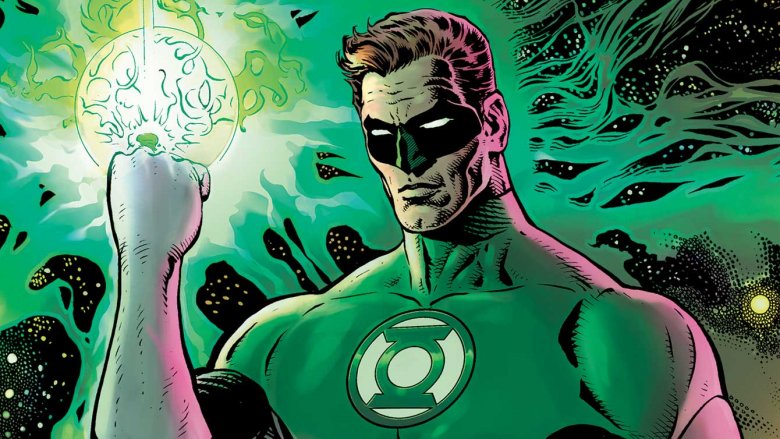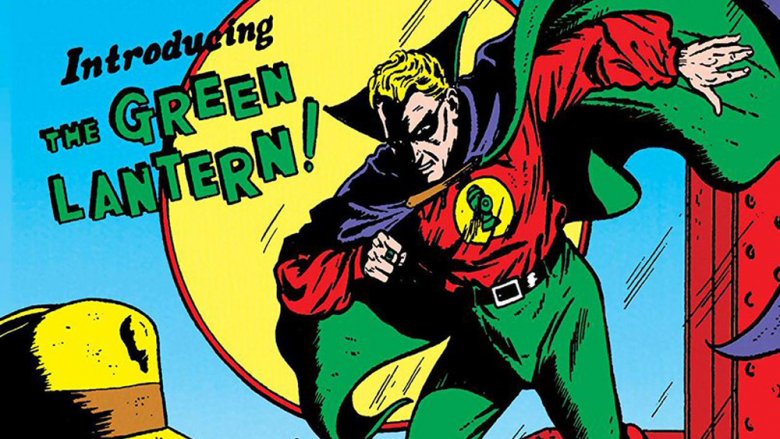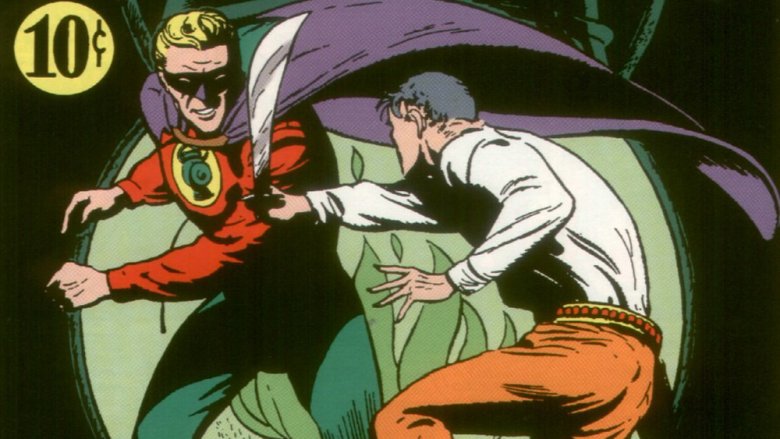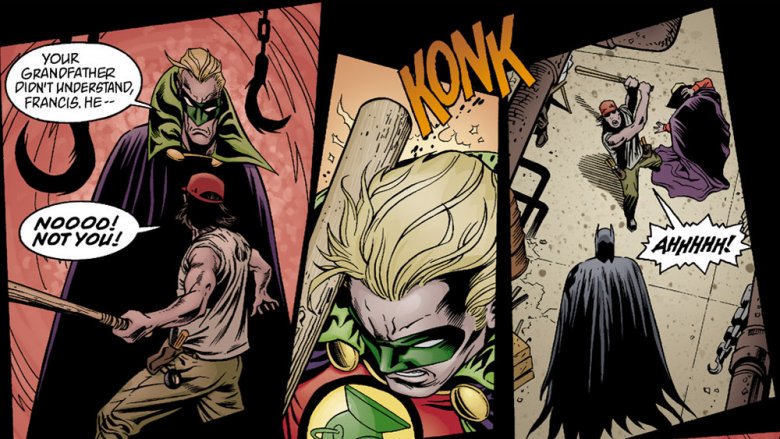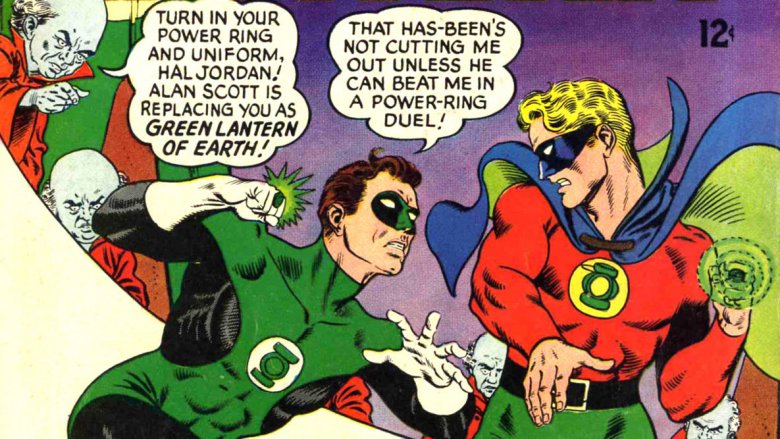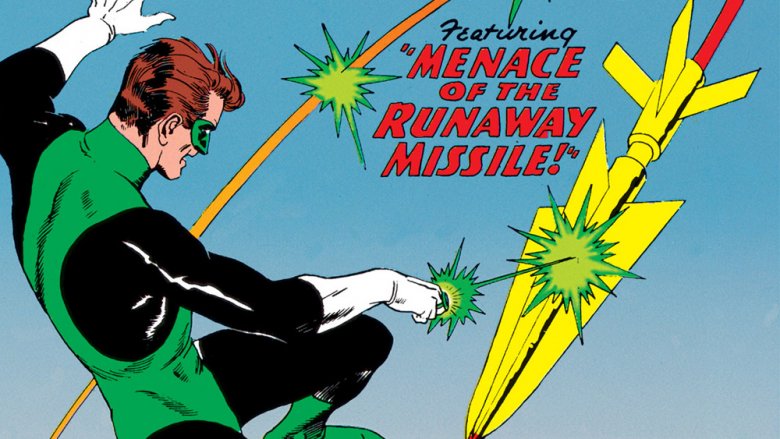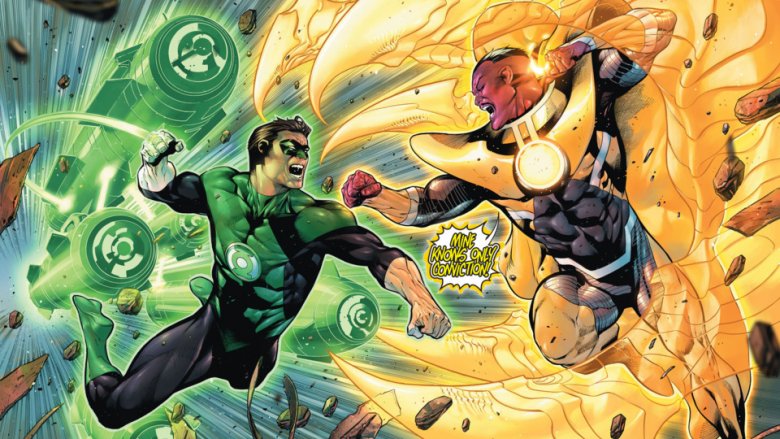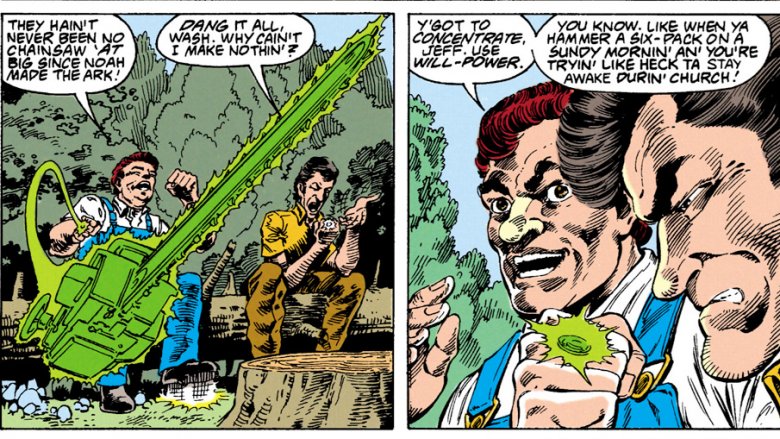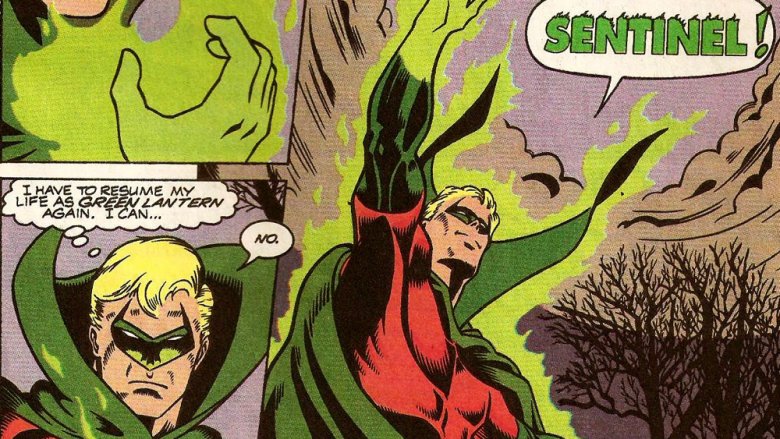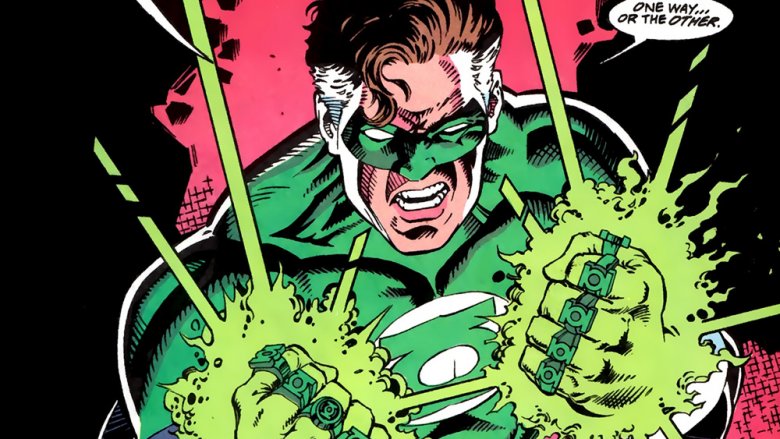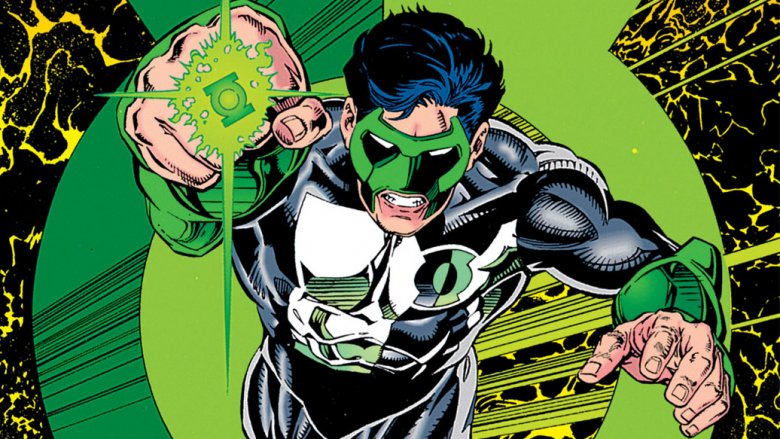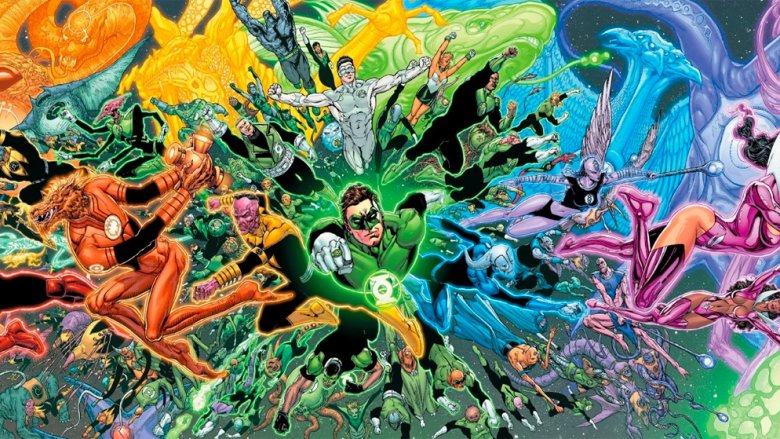The Untold Truth Of Green Lantern's Power Ring
Comic books are full of interesting accessories, from the mystical Eye of Agamotto and the symbolic shield carried by Captain America to the relatively mundane bat-shaped boomerangs that the Dark Knight uses to bop murderous clowns and former district attorneys upside the head. Even with all of those, however, there's no weapon in superhero history that's more powerful than the Green Lantern power ring.
It's also a deceptively complicated piece of equipment for something as simple as a ring. It's limited only by its wielder's imagination, but it also has a finite amount of power. It can create things out of thin air, but only if it's physically present. And it has a necessary impurity that turned out to not actually be necessary at all. If you're curious about it, though, worry no longer. We might not have an Oan instruction manual, but we do have the untold truth behind the evolution of, complications with, and inspiration for Green Lantern's famous power ring.
The Green Lantern's origins
With most of the original Golden Age superheroes, the inspiration their creators were drawing on for their characters is pretty easy to figure out, sometimes embarrassingly so. With Superman, for example, Jerry Siegel and Joe Shuster were inspired by Philip Wylie's novel Gladiator and popular pulp character Doc Savage — you know, Doctor Clark Savage, the Man of Bronze, who has a Fortress of Solitude at the North Pole? Batman was initially just Bill Finger and Bob Kane's riff on the Shadow, and the Joker was visually inspired by a silent film called The Man Who Laughs.
Green Lantern, however, is a whole lot harder to pin down. The idea of a ring that can create solid images of anything the wearer can imagine doesn't really have an obvious immediate predecessor. The closest thing to a magic green light that would've existed in pop culture at the time would've been the green light at the end of Daisy Buchanan's dock in The Great Gatsby, and linking F. Scott Fitzgerald's use of color symbolism to the first appearance of Green Lantern is something even the most daring high school essay writer wouldn't try.
The broader strokes of the origin story, however, are a little easier to figure out. There are plenty of magic rings in fiction, going all the way back to mythology, but there's one in particular that seems relevant here. Before it's turned into its traditional shape, the green lantern in Green Lantern is actually an oil lamp, like the kind seen in Arabian Nights, which is also where we can find the other connection. While the lamp is the item most commonly associated with Aladdin and his genie, the original version of that story has a second genie that appears when Aladdin rubs a ring, through which he can create anything he can imagine.
As for the color, a lot of Golden Age characters drew inspiration from Baroness Orczy and her famous character, the Scarlet Pimpernel. So yeah, comic writers gave their heroes names built around their various hues — Blue Beetle, Red Tornado, and so on. In 1939, green hadn't been used that much, and, well, "Green Lantern" just sounds better as a title than "Green Lamp."
Alan Scott, the All-American hero
While comic books had existed before 1938, Superman's first appearance in Action Comics #1 introduced readers to a whole new genre and started a rush of popularity that sparked a wave of imitators. In 1939, a competing superhero publisher took a shot at creating their own flagship hero. All-American Comics had initially been built around military adventure stories like Red, White, and Blue, about a trio of soldiers, but issue #16 featured Martin Nodell's new creation: the Green Lantern.
While the guy who would eventually use that name as a superhero, Alan Scott, was right there at the start of things, the star of the story was absolutely the Lantern itself. It got a complete origin story of its own, starting when a meteor crashed in ancient China and, speaking with its own voice, delivered a prophecy that it would flame three times, bringing first death, then life, then power. With that, a lamp-maker named Chang decided to carve the meteor into an oil lamp, which is an interesting choice when you're confronted with a talking rock from space, but lamp-makers gonna lamp-make.
When the rest of his village tried to attack him to get rid of what they assumed would 100 percent be cursed, the lantern flamed and killed them all. And thus, we've got death. Hundreds of years later, with no explanation, the lamp wound up in "an asylum for the insane," where it flamed again and cured a man named Billings of his mental illness after he recarved it into a lantern, thus granting life. Finally, it ended up on a train that was crossing over a new bridge designed by engineer Alan Scott. The bridge was blown up by a rival engineer, but Scott survived, and the lantern granted him the power to get his revenge.
Weirdly enough, it was the lantern itself that suggested that Scott break himself off a piece and carve it into a ring so that he doesn't have to haul around the whole thing. For a sentient prophesying meteor, it definitely didn't seem to mind being hacked up into various objects.
Sticks, not stones
Initially, the Green Lantern's "power ring" was a different sort of weapon than what it would eventually become. In the first story, it gave Alan Scott the ability to fly, turn invisible, pass through walls, and become bulletproof, and within a few years, it would be able to blast his enemies with green flames and even read their minds. The idea of forming constructs, which would become the signature power of the Green Lantern character, wouldn't come along until a few years later.
There were, however, a few elements in that first story that would endure for the next 80 years. The first was the ring's insistence that Scott's power was nearly infinite, as long as he believed in himself, and that "willpower is the flame of the Green Lantern." The second was the idea of an oath that Scott would recite when he charged the ring, which originally went, "I shall shed my light over dark evil, for the dark things cannot stand the light of the Green Lantern!" Not quite as catchy as the little poem that would become a sort of nerd shibboleth after the Silver Age, but it definitely set a precedent.
Perhaps most importantly, that story introduced the idea of a weakness for the ring. That was actually something of a novelty at the time. Superman wouldn't have his Kryptonite until 1943, and even then, it was introduced first on the radio show, partly to incapacitate Superman and allow the voice actor a break from the daily broadcasts. Martin Nodell, on the other hand, presumably realized the benefit of giving a character with ill-defined, seemingly infinite powers a weakness in order to create drama. In this case, Scott's weakness was originally characterized as him being "only immune to metals," but it was later refined into being weak to anything made of wood. It seems random, sure, but it did come into play pretty frequently when it turned out his arch-enemy was a swamp zombie.
The ring in silver
Green Lantern was one of the more popular characters in the Golden Age, but like a lot of his contemporaries, his star would eventually fade as the comics industry went through its first big contraction. Despite being featured in his own self-titled magazine and as a member of the Justice Society of America, comics' first big super-team, Alan Scott made his final appearance in 1951.
But then came the Silver Age. In 1956, DC Comics found some success rebooting another all but forgotten Golden Age character, the Flash. Rather than just bringing back the original, they kept the name and the super-power, but tossed everything else in favor of a whole new character. It worked so well, in fact, that by the start of the '60s, DC was digging through their back catalog to find more characters for the same treatment.
The rebooted Silver Age roster would eventually grow to include new revamped versions of almost all of the heroes who'd been around in the '40s. The big shift came from ditching the distinctly pulpy elements of the '40s and replacing most of them with the genre that was growing in popularity in the '50s and '60s: sci-fi. With that in mind, they were all redesigned to fit in the universe and aesthetic that had evolved around Superman, Batman, and Wonder Woman — the characters who'd been popular enough to endure that mid-'50s collapse. The Flash, appropriately enough, was the first to arrive, but it wasn't long before he was joined by the Atom, Hawkman, the Red Tornado, and even a revived Justice Society, which was renamed as the Justice League because — no joke — the people at DC figured that kids were more into leagues than societies because of major league baseball's American and National Leagues. Out of all of the characters to be rebooted in the wake of the Flash's success, though, the most successful reimagined character by far was, of course, Green Lantern.
Green Lantern 2.0
While virtually all of DC's Silver Age reboots came with a heavy dose of space fantasy, Green Lantern went further than anyone in swapping out the pulpy mysticism for full-on science fiction. Just like in Alan Scott's debut, Hal Jordan — a jet-setting atomic age test pilot, not a civil engineer — had an origin story that involved the eponymous lantern crashing to Earth from space. Rather than being a magic talking meteor that had been foretold in an ancient Chinese prophecy, though, 1959's Green Lantern was a weapon carried by an alien peacekeeper who'd been shot down in a UFO crash and who recruited Hal as his replacement.
If that wasn't enough sci-fi, that story also introduced the Guardians of the Universe, little blue men with big heads — the visual shorthand for super-evolved psychic beings that cropped up a lot in comics from the era — who divided outer space into 3,600 sectors, each with its own assigned space cop. Each one had a ring that needed to be charged with a lantern-shaped power battery every 24 hours, another holdover from Alan Scott's tenure, but was otherwise limited only by its wielder's imagination and willpower.
The one exception was a "necessary impurity" that made it powerless against anything yellow. Originally, this was explained as being some weird flaw in the power battery's construction, without which it would lose its power. But it got another, more reasonable explanation in 1991, which was that the Guardians didn't want the Green Lanterns to be completely unstoppable. Given what happened back in 1961's Green Lantern #7, that was probably a good idea.
Sinestro and the yellow power ring
One big difference between the Golden Age Green Lantern's ring and his Silver Age successor's was that Hal Jordan's ring wasn't exactly unique. At the bare minimum, there were 3,599 others just like it, and that idea proved to be the central to the Green Lantern story in multiple, very important ways. The first was that the rings — and the Green Lanterns themselves — could be replaced, which was the very first thing that happened in a Silver Age Green Lantern story when Hal Jordan took over for the deceased Abin Sur.
The second was that if the ring wasn't unique, then there was no reason why a bad guy couldn't have one of his own. Thus, we got Sinestro, a villain who debuted in Green Lantern #7 with his own power ring. The backstory was that Sinestro had been a Green Lantern himself (Sector 1417, if you're curious) who used his ring to become the tyrannical absolute ruler of his home planet, Korugar. The Guardians stripped him of his power, so naturally, he went to the Qwardians, the Guardians' evil counterparts from the Anti-Matter Universe. You know, as one does.
The Weaponers of Qward gave Sinestro a power ring that was exactly like the one he'd wielded as a Green Lantern but with one key difference: It was yellow. This would seem to be exactly what someone would need to do a murder on Hal and his 3,599 coworkers, but despite having the advantage, Sinestro has pretty consistently failed to get the job done.
No courage required
For most of its history, the power ring has come with a few additional requirements for its use. In Hal Jordan's time, the Guardians only recruited beings who were honest and fearless. In more modern stories, using the ring required its bearer to be able to feel fear and overcome it, and the act of focusing one's willpower enough to actually make it work was shown to be so difficult that it left inexperienced users physically exhausted. That, however, was not always the case, as evidenced by the time that two drunk rednecks found a couple of them at a bar and decided to goof around in the woods making giant chainsaws.
No, really. It happened in Green Lantern #3 from 1990. In that comic, Hal Jordan and Guy Gardner, both of whom were Green Lanterns, got so mad at each other that they decided to settle their differences the old-fashioned way, taking off their rings for a fair fistfight. Unfortunately, they got so caught up in the brawl that they were arrested, leaving their rings back at a bar where they were found by two country boys named Jeff and Wash. Those two went out to the woods and, while speaking with ridiculous Southern accents that even Rogue from the X-Men would think were a little over the top, used them to make constructs like gigantic beers and a 20-foot raccoon.
To be fair, it wasn't easy, but it wasn't quite the physical strain that would be shown in later, grittier stories. For them, it was more like "when ya hammer a six-pack on a Sunday mornin' an' you're tryin' like heck ta stay awake in church!"
Green Lantern 1.5: Meet the Sentinel
Originally, Alan Scott and Hal Jordan were residents of different universes — Earth-2, the home of the Golden Age heroes, and Earth-1, the primary universe that essentially kicked off with the Silver Age Flash's debut in Showcase #4, respectively. The idea of being equivalents on parallel but very different worlds was a decent explanation for why their rings, which had the same powers and gave them the same heroic code names, had such different origin stories.
In 1986, however, DC scrapped the multiverse in favor of a single, streamlined timeline that would encompass the entire history. Alan Scott and Hal Jordan were now part of the same timeline, which meant that having a hero from the '40s with a magic power ring called Green Lantern and a present-day hero with a completely unrelated "magic" power ring was an awfully big coincidence. The solution was to tie those characters together as part of a single legacy, but doing so without altering either of their origins required a bit of work.
The solution was the Starheart, an artifact created by the aforementioned Guardians of the Universe millions of years ago when they tried to cleanse the universe of magic. The Guardians essentially gathered up all of the mystical energy they could find and then confined it to the Starheart, which eventually made its way to Earth as a meteor, where it was carved into the shape of a lamp, then a lantern, and eventually into the Golden Age Green Lantern's ring. This tied its origin, and Alan Scott himself, back into the Guardians of the Universe and the modern Green Lantern Corps, with the Starheart magically influencing its owners to give it its familiar green lantern shape.
With all of this settled and a couple of very different origin stories taped together into a more-or-less cohesive whole, Alan Scott's codename was changed to "Sentinel" in order to distinguish him from the other Green Lanterns, although he'd go back to his original title eventually.
Mo' power rings, mo' problems
While the Green Lantern power ring was often referred to as the most powerful weapon in the universe, that power had its limitations. Hal Jordan found that out in 1994, when his hometown was destroyed along with most of the people he loved. And the kicker? It didn't even happen as part of a Green Lantern story. It was during The Death of Superman.
Perhaps understandably, Hal snapped under the pressure. After trying and failing to recreate Coast City and its population using his ring, he decided that what he needed was more power, in the form of more rings. Since the only way to get more rings was to take them from the other Lanterns, Hal embarked on what was basically a campaign of space-murder, killing nearly all of his fellow Lanterns and taking their rings, eventually making it to the central power battery on the Guardians' home planet of Oa, where he absorbed the power of the rings and the battery into himself.
The result was Parallax, an incredibly powerful supervillain with seemingly unlimited power. He had so much power, in fact, that he was able to re-ignite the sun after it was extinguished by a cosmic weapon called the Sun-Eater. Plus, he resurrected his old pal Green Arrow from the dead, and he even made a pretty effective attempt to restart time itself. Eventually, Hal would die, and then become the Spectre, the embodiment of the literal Wrath of God. That sounds like a big deal, but in terms of power, it turned out to be a lateral move at best.
Green Lantern 3.0
While Hal got all of the existing Green Lantern rings during his journey to becoming Parallax, there was one that he missed: his own. When he absorbed the energy of the central power battery, he took his own ring off and stomped on it, symbolically forsaking his role as Green Lantern. After he left, though, the only surviving Guardian, Ganthet, remade it into a new ring, teleported himself to Earth, and gave it to Kyle Rayner, a guy who just happened to be walking by. Seriously, Ganthet's exact words were, "You shall have to do."
Kyle's ring had a few differences, most importantly that it didn't have the weakness to the color yellow. It also didn't need to be charged every 24 hours, instead having a finite amount of energy that it would burn through before needing a recharge. As for how much energy, it was loosely defined as "whenever the plot needs a little extra drama."
It's worth noting that this ring managed to survive to the distant future — or, at least, one of the DC Universe many distant futures. During the DC One Million event, the ring was thought to have disappeared before it finally resurfaced in the 853rd Century, disguised as a chunk of green Kryptonite as part of a master plan that had been constructed over thousands of years. At the time, Superman had been living in a "Solar Fortress of Solitude" in the heart of the sun, mainlining the solar energy that gave him his powers, for longer than anyone could remember. When some bad guys tried to shoot this "Kryptonite" at the sun to poison its light and thus kill Superman on the day he was supposed to return from his isolation, they were actually just handing him a Green Lantern ring.
In other words, these villains accidentally gave Superman, who'd been charged up by the sun for centuries and was at the height of his own powers, the most powerful weapon in the universe. It did not work out well for them.
The emotional spectrum
The next big development for the Green Lantern rings came in 2005, with the introduction of the "emotional spectrum." It turned out that there weren't just green and yellow rings. Instead, there was an entire rainbow of Lantern Corps, with each color tied to an emotion that powered its respective ring.
Green was willpower (not an emotion), yellow was fear, blue was hope, and red was rage (which involved its bearers vomiting blood and replacing it with hate, which is pretty amazing). Orange was greed, indigo was compassion, and violet was love. Then came the reveal that there were two more. Black was death (also not an emotion), and white was life (again, not an emotion). Then, later, just to take things to its most logical and delightful extreme, it turned out there was also a spectrum for invisible emotions that included ultraviolet and infrared lanterns, which were tied to emotions we'd prefer not to acknowledge. Each ring functioned more or less like the familiar green ones, and there were reimagined classic Green Lantern villains as extensions of those corps, like Star Sapphire (violet) and the Black Hand (black, obviously). The only big difference was that there was no corps for the Orange Lanterns, as the embodiment of avarice wouldn't want to share their power.
Along with this came the reveal that each of the colors was embodied by an entity. The Green Entity, for example, was Ion, a giant, glowing space whale, while it turned out that Parallax was actually the Yellow Entity, a space locust that had been secretly possessing Hal Jordan when he went bad. Oh, and the entity representing love is called the Predator, but it's not that Predator. If it was, the classic Schwarzenegger movie would've been very different.
